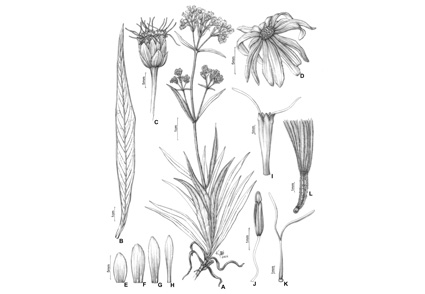Abstract
The southeastern Brazilian phytophysiognomy of “campos de altitude” is threatened by the global temperature increase, and because of it, many of its endemic species, such as those of the Asteraceae family, may disappear over the next years. This new species, which occurs in this type of environment, belongs to the genus Heterocondylus (Eupatorieae: Asteraceae), which comprises seven species, mainly with South American distribution. This genus is morphologically variable but all its species share the diagnostic characters, such as: enlarged basal style with variable indumentum, and cypselae with an asymmetrical carpopodium composed of cells with thickened walls. Heterocondylus penninervius is described as a new species from the “campos de altitude” in Serra do Brigadeiro, Araponga municipality, Minas Gerais state, Brazil. The species is recognized by its sessile leaves concentrated in the lower part of the stem, with narrow-elliptical to narrow-lanceolate blade and penninerved leaves, as well as broad capitula with white and pinkish phyllaries. This study provides the description, illustration, taxonomic affinities, flowering and fruiting period and geographic distribution of the species.
References
<p>Aximoff, I. (2011) O que perdemos com a passagem do fogo pelos campos de altitude do Estado do Rio de Janeiro? <em>Revista Biodiversidade Brasileira, Número Temático: Ecologia e Manejo do Fogo em Áreas Protegidas</em> 2: 180–200.</p>
<p>Benites, V.M., Schaefer, C.E.G.R. & Simas, F.N.B. (2007) Soils associated to rock outcrops in the Brazilian mountain ranges Mantiqueira and Espinhaço. <em>Revista Brasileira de Botânica </em>30: 569–577. https://doi.org/10.1590/S0100-84042007000400003</p>
<p>Cassini, A.H.G. (1819) XIX Tribu Les Eupatoriées (Eupatorieae). <em>Journal de Physique, de Chimie, d’Histoire Naturelle et des Arts</em> 88: 202–203.</p>
<p>Fernandes, A.C. (2014) <em>Sistemática de Heterocondylus R.M. King & H. Rob. (Eupatorieae, Asteraceae).</em> Tese de Doutorado. Universidade Federal de Belo Horizonte, Belo Horizonte, MG. 124 pp.</p>
<p>Gottfried, M., Pauli, H., Futschik, A., Akhalkatsi, M., Barančok, P., Alonso, J.L.B., Coldea, G. ,Dick, J., Erschbamer, B., Calzado, M.R.F., Kazakis, G., Krajči, J., Larsson, P., Mallaun, M., Michelsen, O., Moiseev, D., Moiseev, P., Molau, U., Merzouki, A., Nagy, L., Nakhutsrishvili, G., Pedersen, B., Pelino, G., Puscas, M., Rossi, G., Stanisci, A., Theurillat, J.-P., Tomaselli, M., Villar, L., Vittoz, P., Vogiatzakis, I. & Grabherr, G. (2012) Continent-wide response of mountain vegetation to climate change.<em> Nature Climate Change </em>2: 111–115. https://doi.org/10.1038/nclimate1329</p>
<p>Hind, D.J.N. (1993) Notes on the Compositae of Bahia, Brazil I. <em>Kew Bulletin</em> 48 (2): 245–277. https://doi.org/10.2307/4117932</p>
<p>IUCN (2019) Guidelines for Using the IUCN Red List Categories and Criteria, version 14. Cambridge U.K. Available from: http://www.iucnredlist.org/documents/ RedListGuidelines.pdf (accessed 20 April 2020).</p>
<p>King, R.M. & Robinson, H. (1972) Studies in the Eupatorieae (Asteraceae). A new genus, <em>Heterocondylus. Phytologia</em> 24: 389–391. https://doi.org/10.5962/bhl.part.17147</p>
<p>King, R.M. & Robinson, H. (1987) <em>The genera of the Eupatorieae (Asteraceae). Monographs in Systematic Botany</em> 22: 1–581. https://doi.org/10.5962/bhl.title.156613</p>
<p>King, R.M. & Robinson, H. (1989) Studies in the Eupatorieae (Asteraceae) CCXXIV. Three previously misplaced South American species. <em>Phytologia</em> 65: 487–488.</p>
<p>Martinelli, G. & Bragança, J. (1996) <em>Campos de altitude</em>. Editora Index, Rio de Janeiro.</p>
<p>Mocochinski, A.Y. & Scheer, M.B. (2008) Campos de Altitude na Serra do Mar Paranaense: aspectos florísticos. <em>Floresta</em> 38 (4): 625–640. https://doi.org/10.5380/rf.v38i4.13158</p>
<p>Nakajima, J.N. & Semir, J. (2001) Asteraceae do Parque Nacional da Serra da Canastra, Minas Gerais, Brasil. <em>Revista Brasileira de Botânica</em> 24 (4): 471–478. https://doi.org/10.1590/S0100-84042001000400013</p>
<p>Panero, J.L., Freire, S.E., Espinar, L.A., Crozier, B.S., Barboza, G.E. & Cantero, J.J. (2014) Resolution of deep nodes yields an improved backbone phylogeny and a new basal lineage to study early evolution of Asteraceae. <em>Molecular Phylogenetics and Evolution</em> 80: 43–53. https://doi.org/10.1016/j.ympev.2014.07.012</p>
<p>Pickering, C., Hill, W. & Green, K. (2008) Vascular plant diversity and climate change in the alpine zone of the Snowy Mountains, Australia. <em>Biodiversity and Conservation</em> 17: 1627–1644. https://doi.org/10.1007/s10531-008-9371-y</p>
<p>Radford, A.E., Dickison, W.C., Massey, J.R. & Bell, C.R. (1986) <em>Vascular plant systematics</em>. Harper & Row, New York. 543pp.</p>
<p>Ribeiro, K.T., Medina, B.M.O. & Scarano, F.R. (2007) Species composition and biogeographic relations of the rock outcrop flora on the high plateau of Itatiaia, SE-Brazil. <em>Brazilian Journal of Botany</em> 30: 623–639. https://doi.org/10.1590/S0100-84042007000400008</p>
<p>Robinson, H. (2006) New species and new combinations in Brazilian Eupatorieae (Asteraceae)<em>.</em> <em>Phytologia</em> 88 (2): 136–153. https://doi.org/10.5962/bhl.part.27426</p>
<p>Robinson, H., Schilling, E. & Panero, J.L. (2009) Eupatorieae. <em>In</em>: Funk, V.A., Susanna, A. & Bayer, R.J. (Eds.) <em>Systematic, evolution and Biogeography of Compositae.</em> IAPT, Washington, pp. 731–744.</p>
<p>Roque, N. & Bautista, H.P. (2008) <em>Asteraceae: caracterização e morfologia floral</em>. EDUFBA, Universidade Federal da Bahia, 69 pp.</p>
<p>Safford, H.D. (1999) Brazilian Páramos I. An introduction to the physical environment and vegetation of the campos de altitude. <em>Journal of Biogeography</em> 26: 693–712. https://doi.org/10.1046/j.1365-2699.1999.00313.x</p>
<p>Safford, H.D. (2007) Brazilian Páramos IV. Phytogeography of the campos de altitude. <em>Journal of Biogeography</em> 34: 1701–1722. https://doi.org/10.1111/j.1365-2699.2007.01732.x</p>
<p>Thiers, B. (2018) <em>Index Herbariorum: a global directory of public herbaria and associated staff</em>. New York Botanical Gardens’s Virtual Herbarium. Avaliable from: http://sweetgum.nybg.org/ih/ (accessed 20 February 2020).</p>
<p>Wehn, S., Lundemo, S. & Holten, J.I. (2014) Alpine vegetation along multiple environmental gradients and possible consequences of climate change. <em>Alpine Botany</em> 124: 155–164. https://doi.org/10.1007/s00035-014-0136-9</p>


